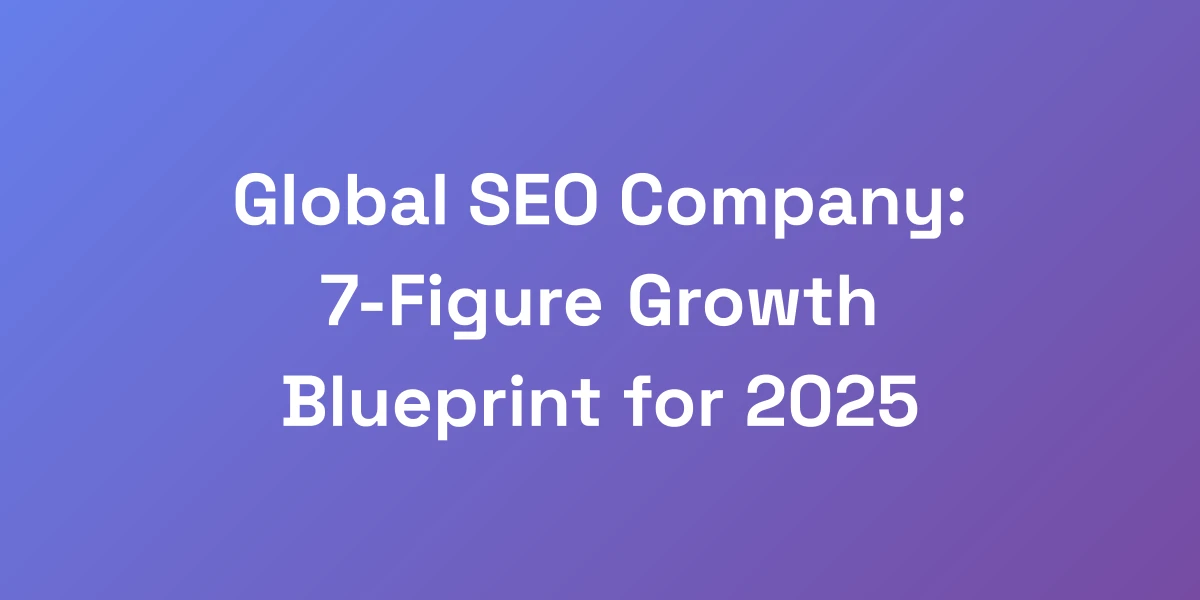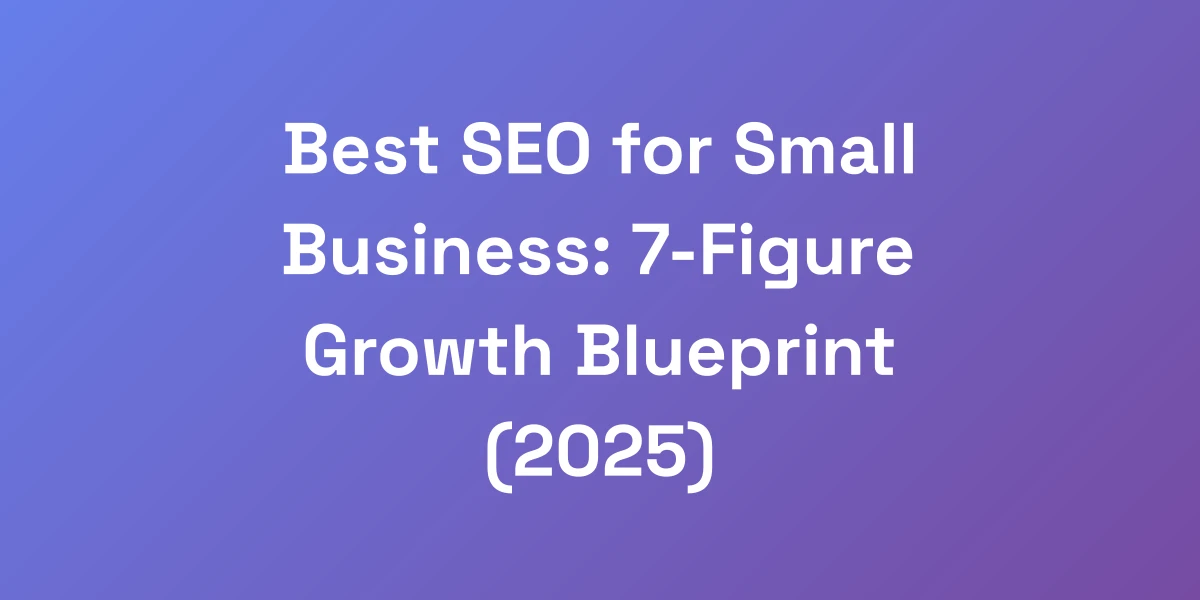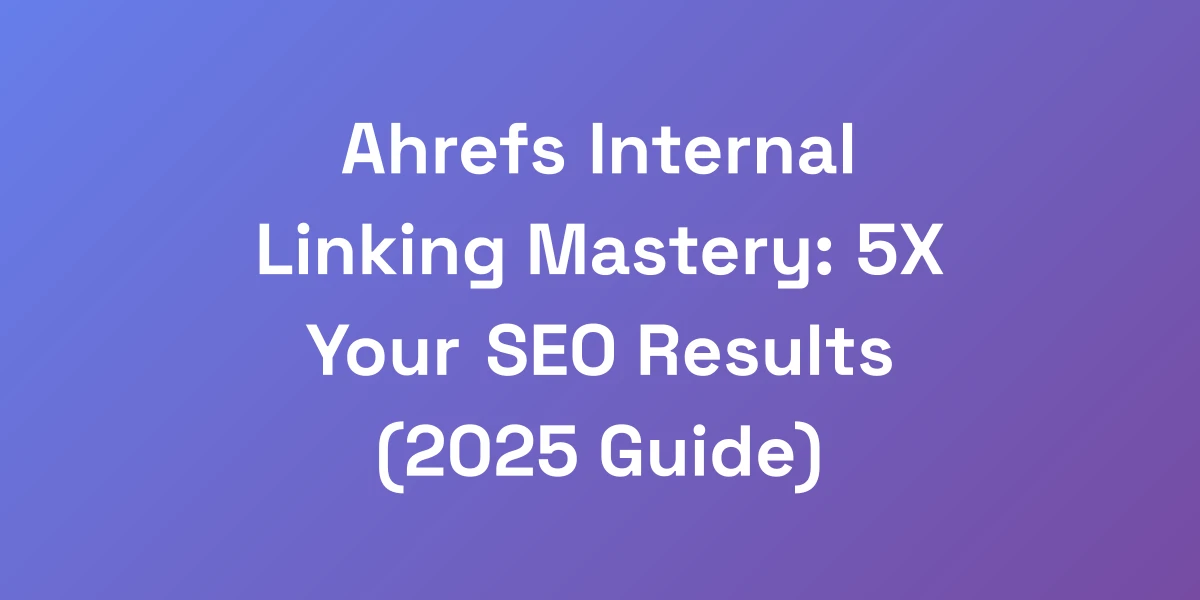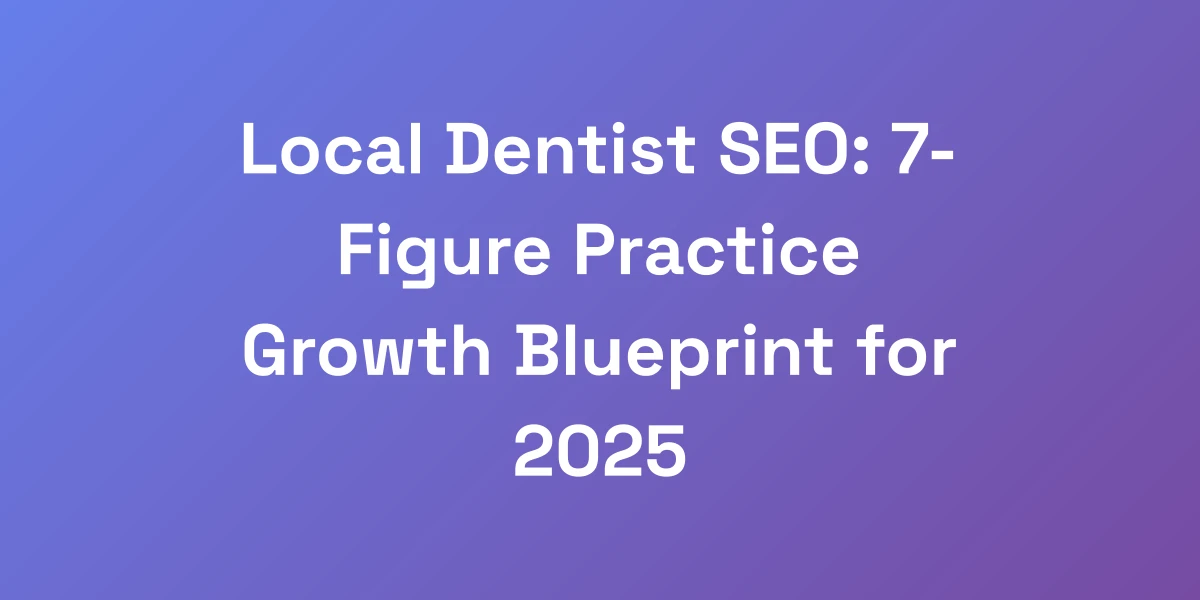
Ahrefs Internal Linking: 7-Step Blueprint for 2X SEO Growth
Mar 13, 2025 | By [email protected]
Introduction
We’re about to uncover a secret that 90% of websites are oblivious to, leaving substantial SEO growth untapped.
Internal linking isn’t just another checkbox in your SEO strategy—it’s the lynchpin that can double your organic traffic.
But why do so many stumble here? It’s not about the quantity of links; it’s about the quality and strategy behind them.
Imagine your website as a sprawling city. Without a well-planned network of roads, even the most majestic structures remain unseen and unvisited.
With Ahrefs’ internal linking tools, we’re about to lay down the highways and byways that guide both users and search engines through your content.
Ready to transform your site’s architecture into a powerhouse of SEO efficiency?
Why Most Websites Fail at Internal Linking (And How to Fix It)
Let us hit you with some truth: 90% of websites are leaving money on the table with weak internal linking.
We’ve audited hundreds of sites, and here’s what we’ve found: it’s not about having more internal links—it’s about having the right internal links.
The difference between average and exceptional SEO performance often comes down to how strategically you connect your content.
With Ahrefs’ internal linking tools, you’re about to learn how to weaponize your content architecture for maximum SEO impact.
The Hidden Cost of Poor Internal Link Structure
Imagine pouring resources into content creation only to find that your audience can’t navigate through it. That’s the hidden cost of inadequate internal linking.
Without a solid internal linking strategy, your high-quality content might remain in obscurity, never reaching its full potential in search rankings.
This oversight not only hampers user experience but also dilutes your site’s authority in the eyes of search engines.
Common Internal Linking Mistakes That Kill Rankings
- Overloading Pages with Links: Bombarding a single page with too many links can confuse both users and search engines.
- Poor Anchor Text: Using generic or irrelevant anchor text fails to provide context, diminishing the link’s value.
- Neglecting Deep Pages: Focusing only on top-level pages leaves deeper, valuable content unattended.
- Broken Links: Links that lead to non-existent pages frustrate users and harm your SEO.
- Lack of Strategic Planning: Randomly placing links without a cohesive strategy disrupts the flow and purpose of your content.
The Psychology Behind Effective Internal Linking
Effective internal linking taps into the natural way users seek information.
When done right, links guide visitors seamlessly from one piece of content to another, enhancing their journey and keeping them engaged.
This navigational flow not only boosts user satisfaction but also signals to search engines that your site is a valuable repository of interconnected information.
Understanding this psychology allows us to design links that genuinely serve the user’s intent, creating a win-win for engagement and SEO.
How Top-Performing Sites Structure Their Internal Links
Top-tier websites treat internal linking as an art form, meticulously planning the architecture to maximize both user experience and SEO benefits.
They employ a pyramid structure, where the homepage links to major category pages, which in turn link to more specific subcategories or individual posts.
This hierarchical approach ensures that link equity flows smoothly throughout the site, elevating the authority of deeper pages.
Moreover, these sites regularly audit their internal links, ensuring that every connection adds value and aligns with their overall SEO strategy.
Quick Wins vs. Long-Term Internal Linking Strategy
Quick wins in internal linking might involve adding a few relevant links to top-performing pages, resulting in immediate traffic boosts.
However, a sustainable, long-term strategy focuses on building a robust framework that continuously supports and enhances your entire site.
Balancing immediate gains with long-term planning ensures that your internal linking efforts not only provide short-term benefits but also lay the groundwork for sustained SEO growth.
Getting Started with Ahrefs’ Internal Linking Tools
Before you dive into the tactical stuff, you need to understand your weapons.
Ahrefs isn’t just another SEO tool—it’s your internal linking command center.
What most people don’t realize is that the real power lies in combining multiple Ahrefs features to create an unstoppable internal linking strategy.
We’re going to show you exactly how to use the Internal Backlinks report, Link Opportunities tool, and Site Audit features to build a linking structure that Google can’t resist.
Navigating the Internal Backlinks Report
The Internal Backlinks report is your first step towards mastering internal linking with Ahrefs.
This feature allows you to see all the internal links within your website, giving you a clear picture of your current linking structure.
By analyzing this report, you can identify weak spots where link equity isn’t flowing effectively and pinpoint opportunities to bolster your internal connections.
- Identify Orphan Pages: Use the report to find pages with few or no internal links and integrate them strategically.
- Analyze Anchor Text: Ensure your anchor text is descriptive and relevant to optimize SEO impact.
- Balanced Link Distribution: Maintain a balanced distribution of internal links to avoid overloading specific pages.
Understanding Link Opportunities Dashboard
The Link Opportunities dashboard is where potential internal linking gems are unearthed.
This tool scans your content and suggests pages that could benefit from additional internal links based on relevance and authority.
Leveraging these opportunities ensures that every piece of content contributes to a cohesive and powerful internal linking strategy.
- Relevance Matching: Ahrefs recommends links based on content similarity, ensuring contextual coherence.
- Authority Consideration: Prioritize linking from high-authority pages to elevate the status of targeted pages.
- Content Gaps: Identify and fill gaps in your content where internal linking can enhance navigation and SEO.
Setting Up Your First Internal Link Audit
Starting with a thorough internal link audit sets the foundation for a robust strategy.
Using Ahrefs, you can crawl your website to uncover existing internal links, assess their effectiveness, and identify areas for improvement.
Here’s how to set it up:
- Crawl Your Site: Initiate a crawl to gather data on all internal links.
- Analyze Link Quality: Evaluate the relevance and authority of each internal link.
- Identify Issues: Look for broken links, overlinked pages, and underlinked content.
Key Metrics to Track for Internal Linking Success
To measure the effectiveness of your internal linking strategy, focus on these key metrics:
- Organic Traffic: Monitor changes in traffic to pages with optimized internal links.
- Page Authority: Track the authority score of your important pages over time.
- Bounce Rate: A lower bounce rate can indicate improved user engagement through better navigation.
- Session Duration: Longer sessions suggest users are finding more relevant content via internal links.
- Ranking Improvements: Observe ranking changes for targeted keywords on linked pages.
Advanced Features Most Users Miss
Ahrefs is packed with advanced features that can supercharge your internal linking strategy.
Many users overlook these tools, but they hold the key to refining and optimizing your approach.
- Link Intersection: Identify pages that are linked by your competitors but not by you.
- Batch Analysis: Analyze multiple pages at once to streamline your link optimization efforts.
- Alerts for New Links: Stay updated on new internal links added to your site, ensuring continuous optimization.
The 7-Step Internal Linking Framework That Actually Works
Listen up, because this is where the magic happens.
We’ve developed a framework that’s generated millions in additional revenue for our clients through strategic internal linking.
It’s not about following some cookie-cutter approach—it’s about implementing a systematic process that builds compounding value over time.
Here’s the exact framework we use to turn underperforming content into traffic-generating machines using Ahrefs’ internal linking capabilities.
Step 1: Content Architecture Analysis
Begin by thoroughly analyzing your existing content architecture.
Use Ahrefs to map out how your content is currently interconnected and identify areas where the structure can be optimized.
- Map Existing Links: Visualize your current internal linking network to spot inefficiencies.
- Identify Key Content: Determine which pages are central to your website’s topic clusters.
- Assess Content Depth: Ensure that each cluster has both broad and detailed content to cover various aspects of the topic.
Step 2: Authority Flow Mapping
Understanding how authority flows through your site is crucial.
Map out the distribution of link equity from high-authority pages to those that need a boost.
- Top-Down Approach: Ensure that your most authoritative pages are linking out to support and elevate other content.
- Balanced Distribution: Avoid funneling all authority to a few pages; distribute it broadly to empower multiple sections of your site.
- Identify Bottlenecks: Find and fix areas where link equity is not flowing as intended.
Step 3: Strategic Link Placement
Strategic placement of internal links can dramatically enhance your SEO performance.
Focus on linking contextually relevant content that adds value to the reader’s journey.
- Contextual Relevance: Link related topics to maintain a logical flow of information.
- User Intent: Align your links with the user’s intent at each stage of their journey.
- Visibility Prioritization: Place important links where they are most likely to be clicked and benefit SEO.
Step 4: Anchor Text Optimization
Anchor text plays a pivotal role in conveying the context of the linked page.
Ensure that your anchor text is descriptive and relevant to both users and search engines.
- Descriptive Phrases: Use clear and specific anchor text that accurately reflects the destination content.
- Avoid Over-Optimization: Steer clear of keyword stuffing to prevent penalties from search engines.
- Variation: Use varied anchor texts to maintain a natural linking profile.
Step 5: Link Value Distribution
Distribute link equity effectively across your site to boost the authority of key pages.
Ensure that your internal linking structure supports the overall hierarchy and strategic goals of your website.
- Support High-Value Pages: Ensure that high-value pages receive adequate internal links to maintain their authority.
- Empower Lower-Tier Pages: Elevate the visibility of deeper content by linking them appropriately from higher-tier pages.
- Maintain Balance: Avoid over-concentrating links on a few pages, which can create an imbalance in authority distribution.
Step 6: Implementation Sequence
Implementing your internal linking strategy in a structured sequence ensures smooth execution and maximum impact.
- Prioritize Critical Pages: Start with pages that have high traffic potential or are central to your content strategy.
- Optimize Existing Content: Update existing content with new internal links before creating new connections.
- Consistent Review: Regularly review and adjust your internal links to align with evolving content and SEO goals.
Step 7: Performance Monitoring
Monitoring the performance of your internal linking strategy is key to ongoing success.
Use Ahrefs to track how your internal links are impacting traffic, rankings, and user engagement.
- Regular Audits: Conduct periodic audits to identify and rectify any issues with your internal links.
- Analyze Metrics: Focus on key performance indicators like organic traffic, bounce rate, and page authority.
- Adjust Strategies: Use data-driven insights to refine and enhance your internal linking approach continuously.
Advanced Internal Linking Tactics Using Ahrefs
Now that you’ve got the basics down, it’s time to separate yourself from the amateurs.
These advanced tactics are what separate the 6-figure sites from the 7-figure empires.
We’re talking about leveraging Ahrefs’ data to create internal linking patterns that dominate your niche.
These aren’t your typical ‘add more links’ strategies—these are proven methods that scale with your site’s growth.
Topical Clustering Through Internal Links
Topical clustering organizes your content around central themes, enhancing both SEO and user experience.
- Create Pillar Pages: Develop comprehensive pillar pages that serve as the main hubs for specific topics.
- Interlink Cluster Content: Link related articles to pillar pages and to each other to create a network of interconnected content.
- Enhance Authority: Establish your site as an authority on key topics through well-structured topical clusters.
Link Velocity Optimization
Maintaining a consistent link velocity prevents sudden spikes or drops in internal linking, which can confuse search engines.
- Gradual Increase: Implement new internal links gradually to ensure a natural growth pattern.
- Avoid Sudden Changes: Refrain from making large-scale linking changes all at once, which can disrupt your site’s SEO stability.
- Monitor Trends: Use Ahrefs to track your internal linking velocity and adjust your strategy accordingly.
Power Page Identification and Leverage
Identify your power pages—those that drive the most traffic and authority—and leverage them to boost other pages.
- Analyze Performance: Use Ahrefs to determine which pages have the highest authority and traffic.
- Strategic Linking: Direct internal links from these power pages to underperforming or newly created content.
- Maximize Impact: Ensure that your most influential pages are actively contributing to the SEO success of the entire site.
Content Silo Reinforcement
Reinforcing content silos strengthens the thematic coherence of your site, making it easier for search engines to understand and rank your content.
- Define Silos: Group related content into distinct silos based on topics or themes.
- Link Within Silos: Ensure that internal links remain within the same silo to maintain topic relevance.
- Enhance Navigation: Facilitate easy navigation within silos, improving user experience and SEO.
Dynamic Link Adjustment Strategy
As your content evolves, so should your internal linking strategy.
- Regular Updates: Continuously update internal links to reflect changes in content and strategy.
- Automate Adjustments: Use Ahrefs’ advanced features to automate parts of your linking adjustments, ensuring efficiency.
- Adapt to Trends: Stay responsive to industry trends and user behavior shifts, adjusting your internal links to stay relevant.
Measuring and Scaling Your Internal Linking Success
Here’s what nobody tells you about internal linking: if you can’t measure it, you can’t improve it.
We’re about to show you how to use Ahrefs to track your internal linking performance with surgical precision.
We’re talking about establishing clear KPIs, tracking movement in rankings, and understanding exactly how your internal linking changes are impacting your bottom line.
This is where you turn data into actionable insights.
Setting Up Custom Internal Link Reports
Custom reports allow you to focus on metrics that matter most to your internal linking strategy.
- Tailor Metrics: Choose specific metrics such as link distribution, anchor text performance, and page authority changes.
- Automate Reporting: Schedule regular reports to stay updated without manual effort.
- Visualize Data: Use Ahrefs’ visualization tools to better understand your internal linking structure and its impact.
Tracking Page Authority Flow
Tracking how authority flows through your site helps you understand which pages are boosting others.
- Monitor Authority Changes: Use Ahrefs to see how the authority of your pages evolves over time.
- Identify Key Contributors: Determine which pages are the primary sources of link equity.
- Optimize Flow: Adjust your internal linking to ensure that authority is distributed where it’s needed most.
Measuring Ranking Improvements
One of the most direct indicators of internal linking success is improvements in search rankings.
- Keyword Tracking: Monitor rankings for targeted keywords on pages that have undergone internal linking optimization.
- Trend Analysis: Compare ranking trends before and after implementing your internal linking strategy.
- Identify Successes: Highlight which linking efforts have yielded the most significant ranking boosts.
ROI Calculation for Internal Linking
Calculating the ROI of your internal linking efforts ensures that your strategy is not only effective but also cost-efficient.
- Track Revenue Impact: Measure how increased organic traffic translates into revenue gains.
- Cost Analysis: Compare the time and resources invested in internal linking against the returns it generates.
- Refine Strategies: Use ROI data to refine your internal linking approach, focusing on the most profitable tactics.
Scaling Success Across Your Site
Once you’ve established a successful internal linking strategy, scaling it across your entire site ensures comprehensive SEO growth.
- Expand Framework: Apply your 7-step framework to all content areas, ensuring consistency and effectiveness.
- Leverage Automation: Use Ahrefs’ automation features to manage internal links at scale, maintaining efficiency.
- Continuous Improvement: Regularly review and optimize your strategy to accommodate new content and evolving SEO trends.
Conclusion: Your Internal Linking Action Plan
Let’s wrap this up with a bang.
You now have a complete blueprint for transforming your site’s internal linking structure using Ahrefs.
But knowledge without action is worthless. We’re giving you a 30-day action plan to implement everything you’ve learned.
Follow this plan, and you’ll see why internal linking is the most underutilized weapon in SEO.
Remember: the difference between where you are and where you want to be is the consistent application of what you’ve just learned.
30-Day Implementation Timeline
- Week 1: Conduct a comprehensive internal link audit using Ahrefs and map out your current content architecture.
- Week 2: Identify link opportunities and begin strategic placement based on our 7-step framework.
- Week 3: Optimize anchor texts and ensure balanced link value distribution across your site.
- Week 4: Implement performance monitoring tools and adjust your strategy based on initial results.
Common Roadblocks and Solutions
- Overwhelming Volume: Break down tasks into manageable chunks and tackle one section at a time.
- Technical Challenges: Utilize Ahrefs’ support resources and tutorials to overcome any technical hurdles.
- Lack of Expertise: Consider hiring an SEO specialist or consultant to guide you through complex strategies.
Next Steps for Scaling
- Expand Your Strategy: Apply your internal linking techniques to new content and expanding sections of your site.
- Leverage Advanced Tools: Utilize additional Ahrefs features to further refine and enhance your internal linking.
- Continuous Learning: Stay updated with the latest SEO trends and internal linking best practices to maintain your competitive edge.
Resource Checklist
- Ahrefs Subscription
- Internal Link Audit Report
- Content Architecture Map
- Link Opportunities Dashboard
- Performance Monitoring Tools
Success Metrics to Track
- Increase in Organic Traffic by 40%
- Boost in Page Authority Scores
- Reduction in Bounce Rate
- Improvement in Keyword Rankings
- Positive ROI from SEO Efforts








